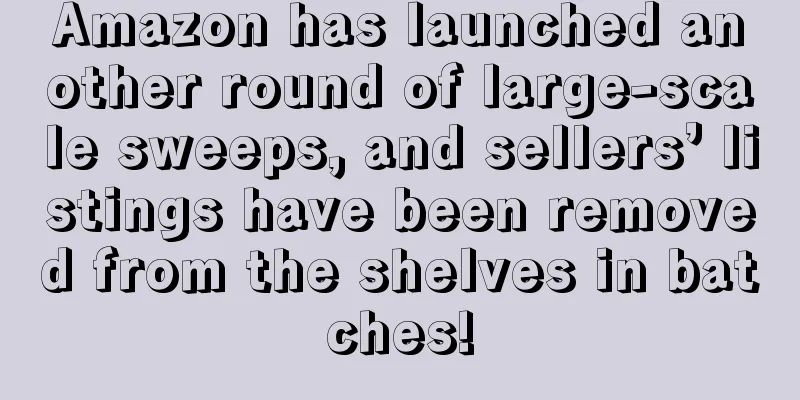"Scanning your ID twice during peak season" seems to have become a routine for Amazon sellers. Recently, the Consumer Notification Act account verification, increased review of new account registrations, and second-instance ID scanning have become more and more serious. With Prime Day As the big sale draws near, Amazon has been using its "dragon-slaying sword" to crack down on all kinds of illegal operations. Recently, a new round of illegal account sweeping has emerged. It is learned that in fact, in March and mid-April, Amazon launched two rounds of variant violation cleanup operations, banning a large number of seller accounts and removing related listings. It is mid-May, and a new month of strict inspections has arrived again unexpectedly, with a larger scale and more intense intensity. In the early morning of May 11, a large number of sellers received email notifications from Amazon about their accounts being blocked. The email showed that according to Article 3 of the Amazon Business Solutions Agreement, the sellers’ Amazon accounts had been deactivated and their listings had been deleted. The sellers whose accounts were blocked had created one or more ASIN variations, violating the platform’s ASIN creation policy. ▲ The picture comes from Zhiwubuyan Sellers whose accounts have been deactivated will enter the appeal box as shown in the figure below, explain the reason for canceling the account, and provide strong evidence such as invoices, receipts, orders or emails to prove that the variants are within the scope of legal merger. ▲ The picture comes from Zhiwubuyan It is understood that this large-scale sweep has affected many sellers. According to feedback from all parties, the sweep situation is basically the same as the previous two rounds, and the sweep of variant violations may continue until December 30: "The ones that were down during the Qingming Festival haven't come back yet, and there will be another wave in May. If there is no response after a week's appeal, we will prepare to move the warehouse." "In March, all accounts authorized by the brand were suspended, except for two. In April, all accounts were suspended, regardless of whether they were authorized or not. Accounts authorized by the brand had no inventory, and stores with inventory and sales were also suspended. They are considered the vested interests of the brand." "Many variants have been removed in the past two days, and the account's permission to merge variants has been restricted. Not only have all the links been removed, but the backend performance has also been eliminated. Now I can't contact customer service, and the mall shows that it is closed." What is even more troubling for many sellers is that stores that are blocked for abusing variants will also trigger cross-site associations . One seller revealed that his Japanese site was blocked on May 11, and two days later his North American site account was also deactivated without any variant violations. Not only that, there are also sellers who strictly abide by the rules and do not merge variations illegally, but they have also been severely cracked down by Amazon and all links have been split. Now they are unable to merge templates and report error 8036: "Due to a policy violation, you will not be able to create variation relationships between ASINs within 30 days", but have not received any email notifications or performance warnings so far. ▲ The picture comes from Zhiwubuyan Overall, although Amazon suddenly removed links and closed stores without any warning, most of the sellers affected had a history of violations, and most of them had previously eliminated warnings by taking courses, which is actually a disguised admission of violation. Therefore, after being detected this time, Amazon directly identified it as a repeat violation. According to Amazon's ASIN creation rules, the following behaviors will be considered as variation violations: - Altering a product’s detail page (either a parent product or a child product) to look completely different than the original product listing
- Changing the detail page of a parent product so it doesn't match the child product
- Adding incorrect child variations that are not true variations of the parent product, adding non-manufacturer created multi-pack variations to an already existing parent pack
For this reason, sellers whose accounts have been blocked need to check the variants in their stores that may lead to violations, adjust the variant combinations, and remove or delete the illegal variants. If the above-mentioned illegal operations are not involved, relevant evidence can be provided to appeal the misjudgment. However, some sellers have revealed that it is extremely difficult to appeal an account, with a success rate of less than 10%, and most people have to wait 90 days to appeal for funds. The continuous wave of illegal scanning of variant accounts has made many sellers miserable. One seller joked : "I was scanned in March and April, but I am finally not included in the scanning this time because I don't have an account." Countless bloody lessons have warned sellers that they must strictly abide by the golden rules of platform operations, especially when the peak season promotion is approaching. They should always avoid crossing the red line to avoid losing both their store and funds, and missing out on the peak season sales. Therefore, in the face of this account scanning incident, sellers should have a deeper understanding of the specific causes of risks and avoidance methods. Only by learning from their mistakes can they avoid being hit by Amazon's unexpected crackdown. An industry service provider analyzed hundreds of variant scanning cases. The results showed that Amazon adopted an indiscriminate attack on targets, affecting new and old accounts, purchased accounts and self-registered accounts, and the proportions were similar. As for the specific reasons for variant violations, some sellers have made the following summary based on the account suspension incident: 1. There were 2-3 warnings from February to April. The performance was eliminated after clicking on the confirmation. In February, the variant violation warning was not clicked, and the performance was always 2. The variant name is incorrect or illegal; the parent and child titles are not similar enough 3. Merge variants from other categories, resulting in large differences in sub-categories; incorporate some ASINs that have not been sold for a long time into the variants 4. Merge the seed link vine plan of the same product; merge the same product with different colors of VINE products; 2 free vines merge 5. Change the details page (change the copy and change the picture), and the changed details are too different from the initial published details Sellers who have been banned for violations such as abuse of variants can take the following actions to appeal. 1. Query warning information. Carefully read the violation warning emails sent by Amazon and thoroughly check for any behaviors that may lead to violations. 2. Remove or delete the offending variant. For the ASIN mentioned in the warning, you need to go to the backend to make the necessary adjustments. This may include modifying the product description, images, or a combination of entire variations to ensure that the modifications can resolve the violations pointed out by Amazon. 3. Write an effective POA. Once you have completed the above steps, you will need to write a detailed POA that clearly states the specific violations and how the steps will be taken to resolve the issues and ensure that the same problem does not occur again. In summary, sellers need to have a comprehensive and in-depth understanding of the official detailed variation policy in their daily creation of ASINs and various operational operations to avoid any violations. Judging from the wave of illegal account sweeping on Amazon, which is getting higher and higher and has the potential to sweep for a long time, the platform's risk control and auditing efforts are becoming more and more stringent, and the trend of compliant operations is constantly upgrading. For sellers, do not take chances, lest you lose your store and regret it.
|










